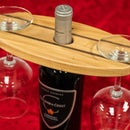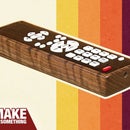Introduction: How to Make an Alaskan Ulu Knife
We've been using an ulu knife in our house for many years. The knife and cutting board in this tutorial is based on one we purchased in Alaska. It's a quick and easy way to cut fruits and veggies as the curvature of the blade rocks back and forth on the mating cutting board for efficient slicing. Full list of supples and tools as well as a free PDF template on my website.
Step 1: Spray Painting the Template
First thing I did was print the template and cut it out with an exact-o knife. I use that as a stencil and spray painted the outline on some sheet metal I got from the home center.
Step 2: Cutting the Blade With a Jigsaw
Using a metal cutting blade on my jigsaw I cut the shape out. I did use some tap magic cutting fluid to keep the metal well lubricated and was surprised on how easy it was to cut with a jigsaw. For the center I needed to drill out a hole for a place to insert the jigsaw blade.
Step 3: Sanding Metal Blade
I then finalized the shape on the disc and belt sander using 120 grit sandpaper.
Step 4: Using a Bastard File
The inside was shaped using a bastard file.
Step 5: Sanding the Blade
I sanded the face sides with my random orbit sander up to 240 grit and then stuck on some synthetic finishing pads to polish the metal.
Step 6: Synthetic Sanding Pads
Once sanded to 240 I then stuck on some synthetic sanding pads to polish the metal.
Step 7: Sand Rough Edges
And then a bit of sandpaper to smooth out the rough edges.
Step 8: Reference Line
For the bevel I just freehanded a reference line along the edge.
Step 9: Sanding the Bevel
I started sanding the bevel using my belt sander to remove a bulk of the material.
Step 10: Finishing the Bevel
Once I got pretty close I then used my Work Sharp 3000.
Step 11: Sharpening Stone
I did some final touches with a sharpening stone and making sure the the back was completely flat.
Step 12: Cutting Out the Handle
I trace out my shape, cut it out on the bandsaw.
Step 13: Resawing the Handle
And then resaw it in half for the two pieces that'll make up the handle.
Step 14: Glue Up
I then glue everything together using some 5 minute epoxy.
Step 15: Brass Dowels
Once the glue dries I then drill some holes for 1/4" brass dowels that is also glued in using epoxy.
Step 16: Finishing
And then some final sanding and a few coats of butcher block conditioner for a nice finish.
Step 17: Making the Cutting Board
For the mating cutting board I'm gluing up some soft maple and walnut.
Step 18: Squaring Up the Cutting Board
Once dry I plane it down to thickness and cut it into a perfect square before chucking it up on the lathe.
Step 19: Cutting Away Bowl
Here on the lathe I'm carving out a concave surface that should allow the knife to rock back and forth for efficient and fast cutting.
Step 20: Finishing the Cutting Board
And once again I do some final sanding and finish it off with butcher block conditioner.
Step 21: You're Done!!
And that's it! You can find a list of supples plus a free PDF template on my website.













